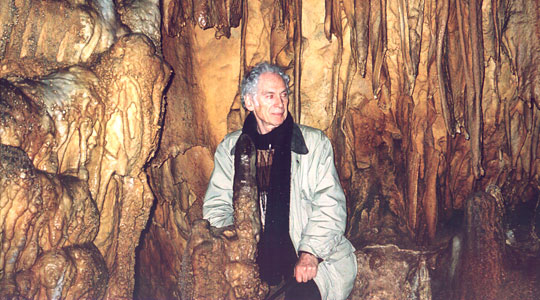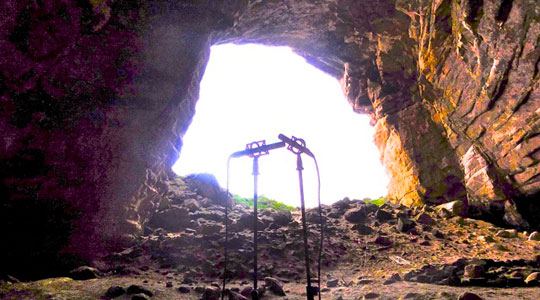Archaeoacoustics – Sound, Myths and Meanings of the Ancient
Lectures, Panel Discussion and Special a Capella Concert

Delving into the sonic mysteries of humanity's distant past, CTM 2015 has dedicated a special series of events exploring the emerging field of archaeoacoustics or archaeology of sound. On Wednesday, 28 January at Kunstraum Kreuzberg Bethanien, lectures by pioneers and leading figures of the field, panel discussions and a special benefit concert (whose proceeds will go towards the aid of Syrian refugees) will reflect on the role of sound in ancient sites and architecture. This gives occasion not only to speculate on ancient listening practices, but also to reflect upon how these might differ from or overlap with contemporary sound practices.
The recently emerged field of archaeoacoustics or archaeology of sound has revisited ancient spaces with new attention to the acoustics and resonant properties of these spaces. Whereas previously they were primarily "looked" at for their visual and architectural characteristics, archaeological sites such as Stonehenge in Avesbury, UK, Malta's Hal-Salfieni Hypogeum, Mexico's Chichen Itza pyramids and Paleolithic rock-art in France and Spain have of late been 'listened' to with keen ears. Research since the 1980s provides increasing amounts of testable scientific evidence indicating the undeniable significance of sound in some pre-historic cultures. Although our modern ears might struggle to understand how, exactly, sound was used and perceived in these ancient cultures, various approaches to do so range from "intuitive" research using voice and listening for resonances to the use of technical-acoustic methods of sine-wave sweeps. In light of CTM 2015's theme, Un Tune, it can be argued that the affective dimension of sound provides us with the biggest clues for understanding sound and the body, even historically.
What does it mean to listen to ancient spaces with modern ears? How does this allow us to reflect upon contemporary listening practices? Arguments by pioneering researcher Iegor Reznikoff expose forgotten practices of singing in just intonation, i.e. in a tuning system used prior to the modern equally-tempered scale, to resonate in medieval and Romanesque churches. Theses scales sound "out of tune" to our ears today, opening up questions about how listening to these scales untune our own familiar Western tonal system. Another key figure in archaeoacoustics, Paul Devereux, discovered a strange phenomenon: several sacred spaces across England and Ireland had resonance frequences around 111Hz. Does the contemporary popularity of 'bass music' and interest in low frequencies reflect the hunger for an affective state that had significance in older cultures too? Rupert Till's research on communal rituals and spiritualistic aspects of electronic dance music culture overlaps thematically with his extensive research on the acoustics of Stonehenge: was loud, rhythmic drum music used for communal rituals in the special architecture of Stonehenge comparable to the music played in today’s clubs?

On Wednesday 28th January in Kunstraum Kreuzberg Bethanien, the day will begin with a lecture with the field's most long-standing protagonist, Iegor Reznikoff, professor of philosophy and mathematics and specialist in ancient music, early Christian chant, resonance and sound therapy. His lecture, "On the Sound Dimension of Prehistoric Painted Caves and Rocks" will explain his pioneering research from the 1980s onwards about the relationship between prehistoric rock art and the these locations’ resonant qualities.
Following this, CTM welcomes Paul Devereux, another leading figure in the field of archaeoacoustics, whose research interests also include studies of ancient and modern consciousness. Devereux's audiovisual presentation (bolstered by his text in the CTM Festival magazine) entitled "Adventures in Archaeoacoustics" will give an overview of his extensive, twenty-year research on the acoustic properties of archaeological sites in Britain, Ireland, the Americas and Malta.
The third and final lecture of the day will come from Rupert Till, reader in music technology and popular music at University of Huddersfield, UK, whose research bridges electronic dance music culture and sound archaeology. His lecture "Entrancement and Entrainment: Techno-shamans from Prehistory to Berghain" will see him examining possible connections between rituals of music and dance in prehistory and those of contemporary electronic music clubs.
An interdisciplinary roundtable discussion will see these three speakers joined by Maria Witek, postdoctoral researcher in music psychology and cognitive neuroscience and Sam Auinger, sound and installation artist whose extensive practice over more than thirty years has is closely intertwined with discourse on the concepts of spatial listening, sound in public space and sonic environments. The panel discussion will be moderated by Annie Goh, co-curator of CTM’s discourse programme.
This video, Songs of the Caves, was created as part of a research project in Northern Spain led by Dr. Rupert Till and colleagues in 2013.
The day's events will be rounded off with a meditative a capella concert by Iegor Reznikoff, world specialist in the music and art of Antiquity. This candle-lit performance will feature Reznikoff’s exploration (with his unamplified voice) of the natural resonant properties of the space of Studio 1, which served as a chapel when the Kunstquartier was still used as a hospital. He will perform pieces of early Christian chant (4th-11th Century) and his own composition "Cantata Grand Magnificat". In light of the ongoing crisis in Syria, all proceeds of this concert will go to charities aiding Syrian refugees.
This video is an excerpt from the concert by Iegor Reznikoff and Dominique Petot-Leconte in the Upper Basilica of San Francesco – Sarva Yoga Conference of Traditional Yoga, Assisi May 1, 2008.
We would like to extend our warmest thanks to the generous support of the Bundeszentrale für politische Bildung (Federal Agency for Civic Education), without whom these events would not be possible.


